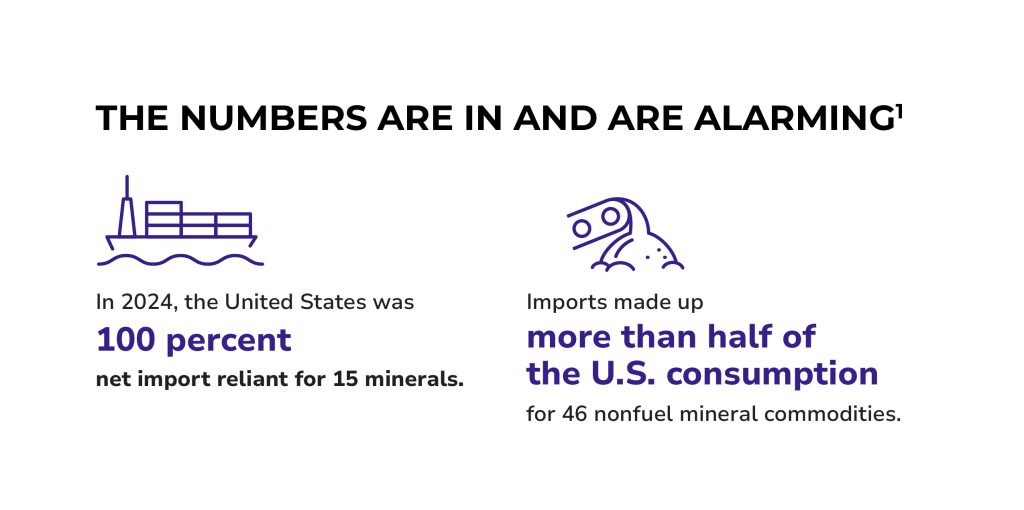December 10, 2025
A Landmark Year for American Minerals Security
A Landmark Year for American Minerals Security ...
Read More ›
The United States continues to face deep vulnerabilities to its mineral supply chains because of its reliance on imported minerals. According to the recently released Mineral Commodity Summaries 2025 report by the United States Geologic Survey (USGS), the United States was 100 percent net import-reliant for 15 minerals in 2024, unchanged from the year prior. As U.S. import reliance grows, so does China’s dominance in the space. China, along with Canada, was the leading source of mineral commodities in 2024.

In late 2024, China announced an export ban on antimony, gallium and germanium to the United States in response to U.S. export restrictions in the chips sector. China currently dominates the global minerals market. As the new administration takes a more aggressive stance on Chinese influence through tariffs, we should expect and have already begun to see additional export restrictions and bans announced by China. Antimony – for which the United States is 100 percent import-reliant – is used to produce flame retardants and munitions. When it comes to essential supply chains, we should be paying especially close attention.
The United States is now at a pivotal juncture. With the growing demand for new technologies such as artificial intelligence and electric vehicles, the demand for minerals is growing exponentially. Batteries and data centers demand large quantities of minerals such as lithium, copper, cobalt and graphite. The U.S. is currently import reliant for all of these minerals, even though large domestic reserves are available.
“In 2024, there were many initiatives and projects in response to legislation passed previously to advance securing American supply chains and supporting domestic production projects.”
– USGS Mineral Commodity Summaries 2025
Concerns over control of the global minerals market stretch beyond the economic consequences and into national security. Adam Burstein, the technical director for strategic and critical materials in the Office of the Assistant Secretary of Defense for Industrial Base Policy, discussed how “it is more urgent than ever to build capability and resilience in supply chains for critical minerals” at the Naval War College earlier this year. Virtually every DoD system is reliant on minerals for production. Relying so heavily on imported minerals makes us highly vulnerable to supply chain disruptions, including those caused by export restrictions and bans from foreign adversaries. While preventative measures, such as stockpiling minerals, may soften the blow of potential disruptions to the supply chain, they are more of a band-aid for the problem than a long-term solution.
The United States currently has no active antimony mines, however, Perpetua Resources is close to bringing online a mine in Idaho that could supply approximately 35 percent of U.S. demand for antimony in the first six years of production, and additional domestic resources have been identified in states like Alaska, Montana and Nevada. Even though China has the bulk of the world’s identified antimony, this is an opportunity to lessen our import reliance for critical minerals within our borders. Other minerals for which the United States is 100 percent import-reliant, like gallium, have also been discovered domestically, most recently in Montana in 2024. So why aren’t we using our resources?
“Seventy percent of Americans want the U.S. to ramp up domestic minerals production to reduce our reliance on China; just 12 percent oppose.”
– Maru Public Opinion Survey
The short answer is that our current policies for domestic mining need reform. Currently, there is significant red tape and no centralized government support for mining, which limits our ability to bring mines online to produce much-needed minerals. This is why the United States has the second longest lead times in the world for developing a new mine, behind Zambia. Bipartisan legislation, like the Energy Permitting Reform Act of 2024, would help reduce the long, complicated and costly process for developing domestic mining projects.
Passing common-sense legislation would allow us to tap into the ample supply of minerals like cobalt, nickel, copper and lithium that can be found within our borders. It would also help speed up the opening and production of sites like the Halleck Creek Project in Wyoming, which holds the potential to be among the largest rare earths deposits in the U.S. and reduce our reliance on China. We simply cannot afford to wait to act because minerals like these are essential to securing a safe and prosperous future for all Americans.